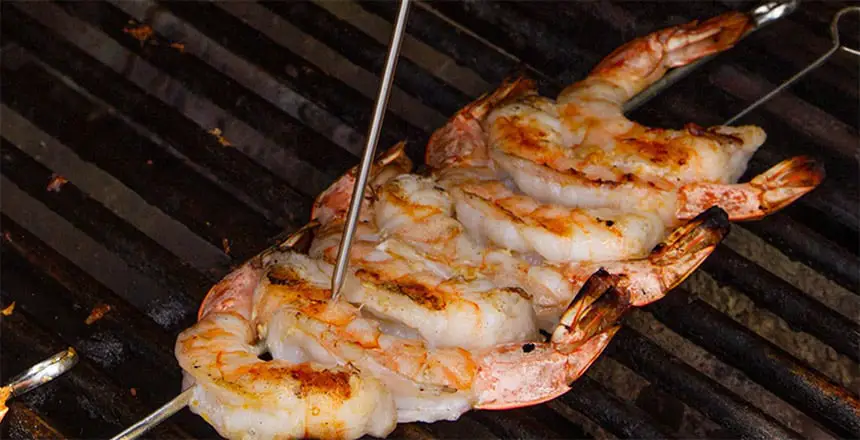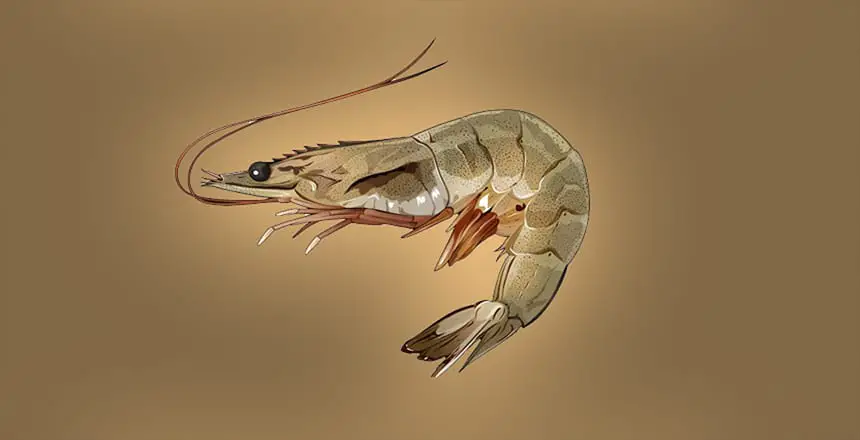Shrimp are delicious and versatile additions to meals across the world. However, it’s important to know what is the safe internal temperature for cooked shrimp – so you can ensure that you and your loved ones get all of the flavors without any of the germs!
In this blog post, we will discuss everything from why cooking shrimp thoroughly is so important, to tips on how to make sure they are properly cooked. Ready to learn more? Let’s dive in!
Related:
- Best Argentine Red Shrimp Recipe
- How Long Does Shrimp Last in the Fridge
- Is Shrimp Keto Friendly Carbs In Shrimp And Recipes
Contents
- What Is The Ideal Shrimp Internal Temperature?
- How To Check The Internal Temperature Of Shrimp?
- How To Check The Doneness Of Shrimp Without A Thermometer?
- What Are The Consequences Of Undercooking Or Overcooking Shrimp?
- How Can I Avoid Undercooking Or Overcooking Shrimp?
- Different Ways of Cooking Shrimp
- Why is Your Shrimp Not Turning Pink?
- FAQs
- Final Thought
What Is The Ideal Shrimp Internal Temperature?
Let’s get straight to the point of answering the million-dollar question: “What is the ideal shrimp internal temperature? The perfect internal temperature for cooked shrimp is 145°F (63°C).
This temperature ensures that the shrimp are fully cooked and safe to eat. Use a food thermometer to check the shrimp’s doneness and make sure it has reached this internal temperature before eating.
How To Check The Internal Temperature Of Shrimp?

Using a food thermometer is the most accurate method to check the internal temperature of shrimp. Place the thermometer within the thickest section of the shrimp and wait for it to register the temperature before taking it out. Make sure that you take an accurate reading and that your shrimp has reached at least 145°F (63°C) before eating.
How To Check The Doneness Of Shrimp Without A Thermometer?
Shrimp can be prepared in a variety of ways, so there are numerous indicators of doneness, including texture, color, opacity, shape, and appearance.
Color
The greatest indicator of a properly cooked shrimp seems to be the color. Shrimp that has been prepared correctly will be solid white and have a pinkish shine. Based on the genus and the prawns’ original hue, the color could vary significantly.
An uncooked prawn typically has a blue-green color. Some shrimp, particularly those that have only been partially cooked, may be translucent and reddish in color. On the other hand, overdone shrimp have a matte or grayish appearance.
Texture
A properly prepared shrimp should have a solid without being chewy structure. Overcooked prawns can be desiccated and tough, whereas undercooked ones are too difficult to consume.
The ultimate texture of a prawn is determined by its form and maturity. Shrimp that are bigger and elderly have a greater amount of connective tissue as well as less moisture, so it takes longer to prepare them and get a delicate mouthfeel.
Appearance
The doneness of your shrimp can be recognized by their appearance. For example, the crustacean diminishes and gets shaggy around the margins as it has lost moisture. Or The proteins’ ragged look is proof that they are transforming and shrinking.
Shape
A cooked prawn tends to have a “C” form to it. As the flesh of the shrimp dries while the protein filaments constrict, a “C” form develops.
An uncooked prawn typically has a straight form. The muscular system and connective cells of the shrimp constrict even more during overcooking, giving it an “O” form.
What Are The Consequences Of Undercooking Or Overcooking Shrimp?

Undercooking shrimp can lead to foodborne illnesses and potentially serious health issues. It is important to make sure that the internal temperature of your shrimp has reached at least 145°F (63°C) before consuming it. Overcooking shrimp can cause them to become tough and rubbery, which makes them less enjoyable to eat. Be sure not to overcook your shrimp in order to preserve their texture and flavor.
How Can I Avoid Undercooking Or Overcooking Shrimp?
While overdone prawns are rubbery as well as flavorless, undercooked prawns may leave you ill. Consider this advice these pieces of advice from experts to prevent undercooked or overdone shrimp:
First, utilize prawns that are identical in size to prevent over- or undercooking. Making them of a similar size at the same period avoids becoming overcooked or undercooked because shrimp may shrink rapidly.
The second tip is to prevent overcooking, remove shrimp from the fire as soon as it’s done. Because shrimp heats up so rapidly, be careful to take it out right away as it looks done.
Instead of masking the taste with seasonings or spices, take the time to prepare the shrimp precisely and make an effort to purchase high-quality shrimp. Shrimp must be cooked carefully and diligently.
Different Ways of Cooking Shrimp
Shrimp can be prepared in a variety of methods, such as grilling, sautéing or even boiling. Shrimp might be broiled or deep-fried. In many recipes, shrimp tastes excellent when mixed with other components.
The flavor and texture of a meal are improved when shrimp are included in the preparation. Try following the instructions below to make shrimp dishes more diverse.
Boiling
Shrimp can be cooked quickly and easily by boiling them. Bring the water to boiling point in a big saucepan and then add prawns.
Observe the water’s temperature as it comes back to a boil after adding the prawns. Take the prawns and place them in a sink of cold water until the water begins to boil once more.
After being cooked, the prawns can be spiced and/or added to a broth. While cooking, prawns may be further seasoned. Salts and other condiments, like juice from lemons and herbs and spices, are typically used when boiling prawns.
Grilling
Shrimp that has been grilled acquire a smoky, woody taste. Heat the griddle to medium before starting to grill the prawns. Sprinkle pepper, salt, oregano leaves, or cumin powder over the prawns and spray olive oil into them.
For about three minutes on each side, place the cooked shrimp onto a griddle over direct fire. When the bottom of the shrimp gets pink, flip it over.
Sautéing Shrimp
Over a medium-high flame, add some olive oil, cloves of garlic, or shallots and cook them until they are tender. Add the shrimp and then sauté it for 1-2 minutes on each side.
Add additional components to the skillet, such as salsa or finely chopped veggies. Offer the shrimp with additional seasonings over rice or noodles after simmering for 4 minutes.
Roasting
Shrimp that is roasted develops a crunchy appearance. Set the oven to 400 degrees Fahrenheit before roasting the prawns.
Flip the shrimp around so that every portion is exposed to the chilly water during the five minutes it spends submerged in the cold water.
Alternate the heads and tails of each prawn in a single sheet. Season the prawns with pepper, salt, basil, herb thyme, lemon juice, as well as other spices, and spray olive oil onto them.
When the lower part of the shrimp gets pink, flip it over. The prawns should be roasted for approximately 3 minutes before being baked until rosy or just beginning to become opaque.
Why is Your Shrimp Not Turning Pink?
It was undoubtedly still improperly prepared if it seems familiar. Although shrimp can come in a variety of hues when fresh, and when completely prepared, they all take on a pink hue.
In other words, when your shrimp fails to turn pink, it’s undercooked. Moreover, shrimp that is undercooked will either be whitish or brownish. Undercooked prawns are going to be straight in shape.
Are you wondering why prawns initially change to pink? It may be because uncooked shrimp includes the color-developing molecule astaxanthin. Astaxanthin occurs naturally in some algae, giving salmon, shrimp, and other seafood their pink or red color.
FAQs
Is it Safe to Eat Undercooked Shrimp?
The answer is no. Food-borne diseases like Staphylococcus and Salmonella aureus infections can result from consuming undercooked shellfish. Therefore, eating correctly prepared shrimp is essential.
What is the Best Method for Cooking Shrimp?
Your particular tastes and, obviously, the amount of time you’re willing to spend preparing will determine your response to this query.
However, sautéing is the most widely used technique if you’re searching for it. In addition to taking only a few minutes, sautéing prawns helps to offer them the finest structure along with juiciness without running the possibility of becoming overly chewy.
Additionally, because it is much simpler to keep a watch on and prevent overcooking when making shrimp using a skillet, there is much less room for mistakes.
How Can Shrimp Be Prevented From Sticking To The Grill?
When grilling, sticking flesh to the griddle is among the most frequent problems. if using shrimp on the barbecue, there are several methods to avoid this.
Making ensuring the barbecue grates are spotless before using them must be the first step. You can remove any residue from your prior grilling use by scraping it off. It’s crucial to marinate your prawns with some oil. By adding oil, you’ll be able to remove the prawns from the barbecue without them sticking to the grates.
Final Thought
All in all, the secret to perfect shrimp boils down to two key steps: proper internal temperature and timing. Aim for a shrimp’s internal temperature of 145°F (63°C).
Use either the feel or sight test — do not soak the seafood in boiling liquid. For visual assurance, you can cook them until they turn pinkish-white or ivory with reddish accents. To ensure exact precision, use a digital kitchen thermometer to check that you’ve achieved the ideal temperature for crab, lobster, and other seafood dishes.
Although it does take a fraction of extra time and vigilance when cooking seafood, it’s definitely worth it. Make sure to properly cook your shrimp so you can save their amazing texture and delicate flavor!
